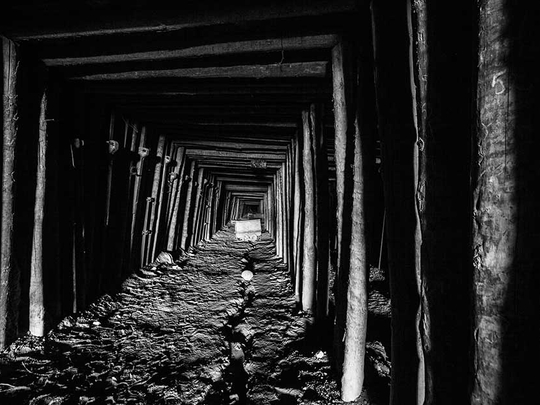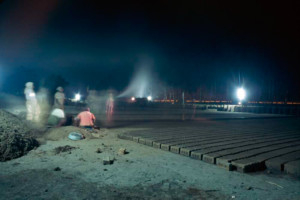
The latest exhibition at 1x1 Gallery, The Star is Mine, brings together artworks by artists from India, Tunisia, Morocco, New Zealand and the Democratic Republic of Congo. The common thread running through the practices of these artists is their concern about the excessive exploitation of natural resources, and its impact on ordinary people and the environment. The show is curated by Sumesh Sharma, co-founder of Mumbai-based Clark House Initiative, and Jordanian Palestinian curator Joud Halawani Al Tamimi.
“This show is about the politics of global resources and its consequences such as the destruction of the environment and displacement of people. It reminds us of the possibilities and limitations of possession. The word ‘mine’ in the title of the show alludes to mining of mineral resources as well as to claiming that land and resources ‘are mine’. Similarly, ‘star’ refers to the fact that many minerals on earth originated from celestial bodies that crashed into our planet, as well as to the idea of our fate being linked to the position of different stars in our astrological charts. Just as astrologers look at the lines on our palms and foretell what the stars have in store for us, the artists in this show are predicting the future of our planet by looking at the scars of mining activity and migration maps on our landscape,” Sharma says.
Many of the artists in the show have a personal relationship with mining and miners. Birender Yadav’s father is a blacksmith working in the coalfields of Dhanbad, an Indian city known for its coal and iron ore mines. The artist was sent to art school in Banaras mainly to develop his skill at making sketches of the implements his father casts in the mine’s foundry.
In a series of paintings titled Inspiration, he has drawn hand gestures that simulate various blacksmithing and mining tools linking his art to his mining background, while also commenting on the gradual replacement of the human hand by machinery. The artist also collaborated with his father to create works such as an axe with a twisted handle, titled An Axe on One’s Own Foot; and Debris of Fate, a series of installations featuring artisanal instruments painted on debris from demolished buildings. These works are also a poignant reminder that traditional craftsmanship is dying and the old way of life is changing.
Indigenous tribes
While in Banaras, Yadav came across people working in the brick kilns who belonged to the indigenous tribes that once inhabited the forests near his hometown. Displaced due to the deforestation of their land for mining and the influx of migrant workers attracted by mining companies, they had fallen prey to gangs who forced them to work in the coal-fired kilns at poor wages. Through works such as a wall made from matchboxes, and paintings created with the powder from matchsticks, the artist talks about flammable social and political situations in the context of control of resources and migration of labour.
Moroccan artist Mouhcine Rahaoui is also the son of a coal miner and his prominently black palette is linked to his memories of his father returning from work covered in soot. His paintings speak about physical and mental landscapes that have been denuded by mining, both on the surface and deep inside.
Zied Ben Romdhane from Tunisia and Indian artist Prabhakar Pachpute both grew up in mining areas and have been photographing mines and miners since the beginning of their practice. Romdhane focuses on the phosphate mines in Tunisia and the lives of the miners who include migrant workers from neighbouring countries. His photographs capture the harsh conditions in the underground mines, and the bleak lives of the miners who risk their health and life doing a job that is important for the economy of Tunisia, yet are marginalised by society. Romdhane’s work has wider relevance because the phosphate mined in Tunisia is used for manufacturing fertilisers in countries such as India, where their excessive usage has rendered large tracts of land unfertile, fuelling farmer distress and migration of agricultural workers.
Pachpute’s focus is on coal mining. He is presenting drawings made from charcoal dust that empathise with the plight of miners and other migrant workers, highlighting the irony of their lives becoming subjects of discussion in art spaces. On a trip to Wales, Pachpute met unemployed coal miners who are eking out a living by carving coal sculptures after their mines were closed. In a series titled There was a Collective in Wales he has paid tribute to these men by casting in bronze the mining souvenirs created by them.
Pachpute has been repeatedly denied permission to shoot in the coal mines near his village. As an act of solidarity with him, artists Yogesh Barve and Amol K. Patil have created a video composed of scenes appropriated from various Hindi films shot in mining areas. The work comments on the glamourisation of mining while its ugly consequences and the grim lives of the miners are ignored. The incantations of Shiva’s dance of destruction in the background drives home the larger message of the work.
Sachin Bonde’s installation, Sounds Good features a set of 10 sculptures of ears on the wall. Hanging from each ear is an unbalanced brass weighing scale, with currency symbols and maps etched on the pans. The work tells us that the earth listens to our needs, but we must also listen to our planet and stop creating an imbalance in nature through our power struggles for resources and territory. In other works, the artist has used conches, roosters, kerosene beakers, and maps to signify conflicts over the ownership and control of land and resources.
Congolese Sammy Balloji’s work often comments on Belgian colonial policies that exploited resources and destroyed the environment in his country, while making Belgium a centre of the diamond trade. He is presenting a video that shows how governments and big corporations are collaborating to steal and exploit land and natural resources from the indigenous people in his country.
Emotional connection
Shanon Te Ao is a New Zealander of Maori heritage. His video speaks about the deep spiritual and emotional connection the Maoris have with nature, while documenting their changing landscape and loss of heritage.
Ravi Agarwal’s photographic series, Down and Out is an intimate portrayal of the lives of migrant workers across India. On the flip side, Moroccan artist Mohammed Fariji’s pictures of old buildings in Casablanca marked for demolition look at how economic development and migration of workers from rural areas leads to the loss of a city’s heritage along with social and architectural changes.
The Star is Mine will run at the 1x1 Gallery, Alserkal Avenue, Al Quoz until December 7.













